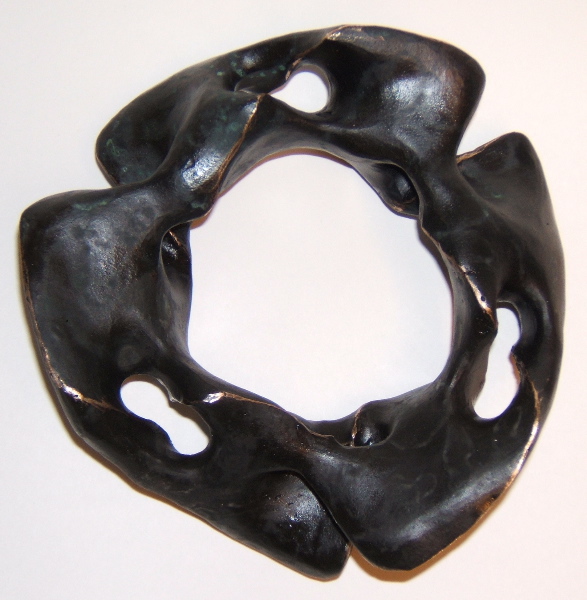Alex J. Feingold
Professor of Mathematics,
Department of Mathematical Sciences,
State University of New York, Binghamton, NY
http://www.math.binghamton.edu/alex/
alex@math.binghamton.edu
"Mathematics is the main inspiration for my sculpture. Many advanced mathematical ideas can be expressed in sculpture, not just simple geometry. I like best small sculptures that can be picked up and handled, so that the tactile impressions are just as important as the image seen by the eyes. Surfaces, edges, curvature and texture are the local characteristics felt, but the larger global design appeals to the intellect and connects to the mathematics. I have tried to incorporate motion and sound into my sculptures. My work is abstract, not representational. I have been working mostly with the lost wax method to create cast bronze sculptures, but I have also used carving and welding techniques to create metal, wood and stone sculptures."
“ Genus 7 Torus Knot”
2007, Bronze with Patina, 5.5" x 6" x 2"
A torus with 6 additional holes (3 vertical and 3 radial) forms a genus 7 surface. That surface has been shaped to emphasize a single curve (knot) which runs around the torus twice, going through each of the six holes twice. Such a knot represents a highly nontrivial element of the first homotopy group of the surface.
“ Figure 8 Knot Rod ”
2007, Bronze Rod, 9" x 5.5" x 5"
A bronze rod 1/4" in diameter was bent into a figure eight knot, and welded into a continuous loop. This is the next most complex knot after the trefoil knot, and its complement in space has a hyperbolic structure. Simple but elegant, this sculpture puts knot theory in your hands in concrete form.
“ Hypocycloid Figure 8 Knot”
2008, Bronze Cast, 9" x 9" x 6"
This picture shows the same figure eight knot as submission #2, but the cross section is a hypocycloid curve (the curve traced out by a point on a circle of radius R rolling with out slipping in a circle or radius 3R). The three vertices of the hypocycloid would trace out three circles on the surface, but because of a one-third twist, there is only one curve, and likewise, only one surface, not three, making an object analogous to the famous Mobius strip.
“ Genus 3 Surface with Three Linked Knots ”
2008, Bronze Cast, 6" x 6" x 2"
This piece is a torus with three pillars meeting in the center (like a steering wheel of a car). The surface is shaped to emphasize three separate curves which are embedded in the surface, each of which go around the outside of part of the torus, along a pillar, and back out, so that they form three knots which are linked with each other. They are symmetrically placed on the surface. After being polished, I might want to apply a patina to the surface, and then sand away the color along the curves so that they stand out, as I did in submission #1, the Genus 7 Torus Knot.